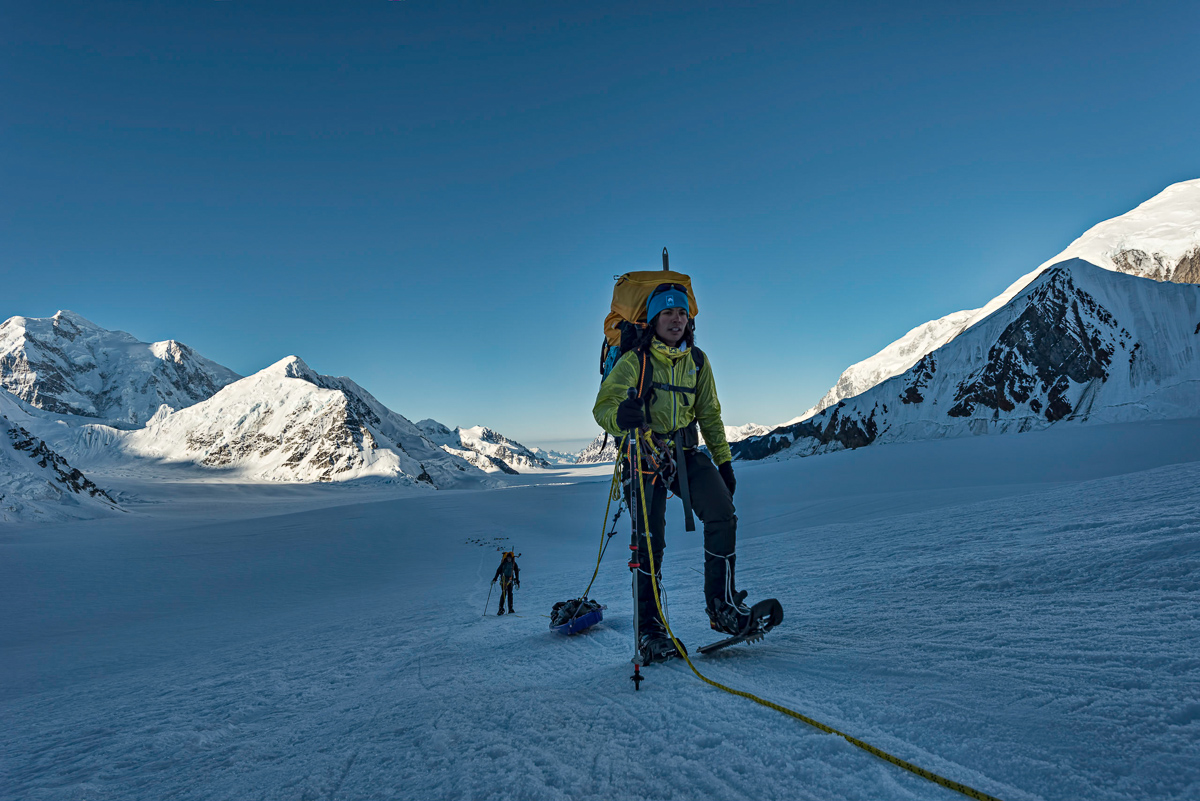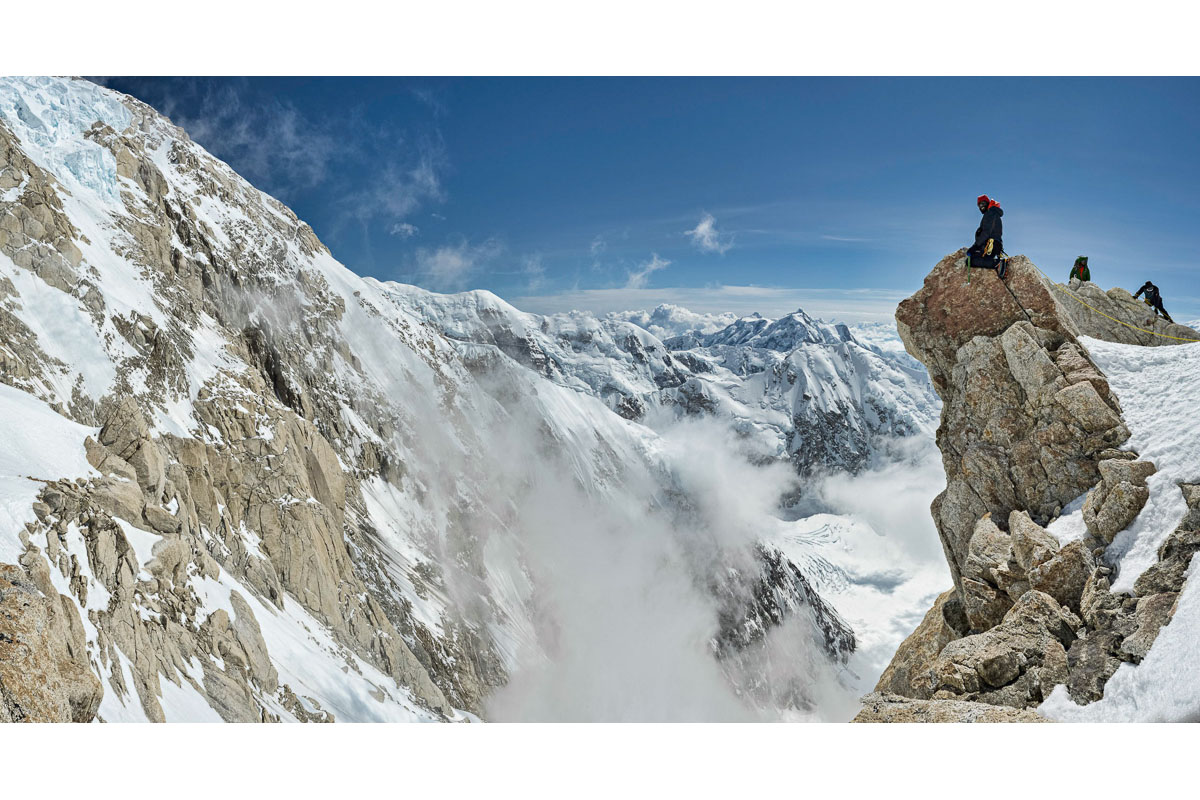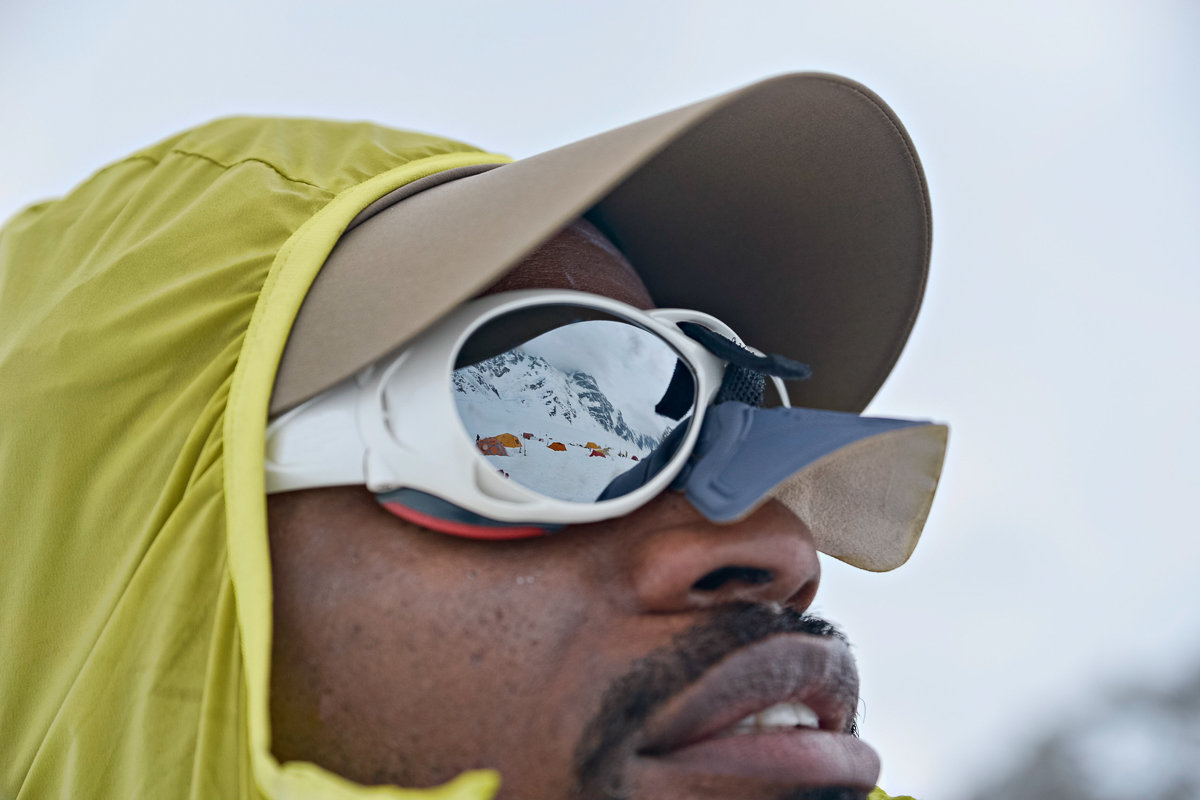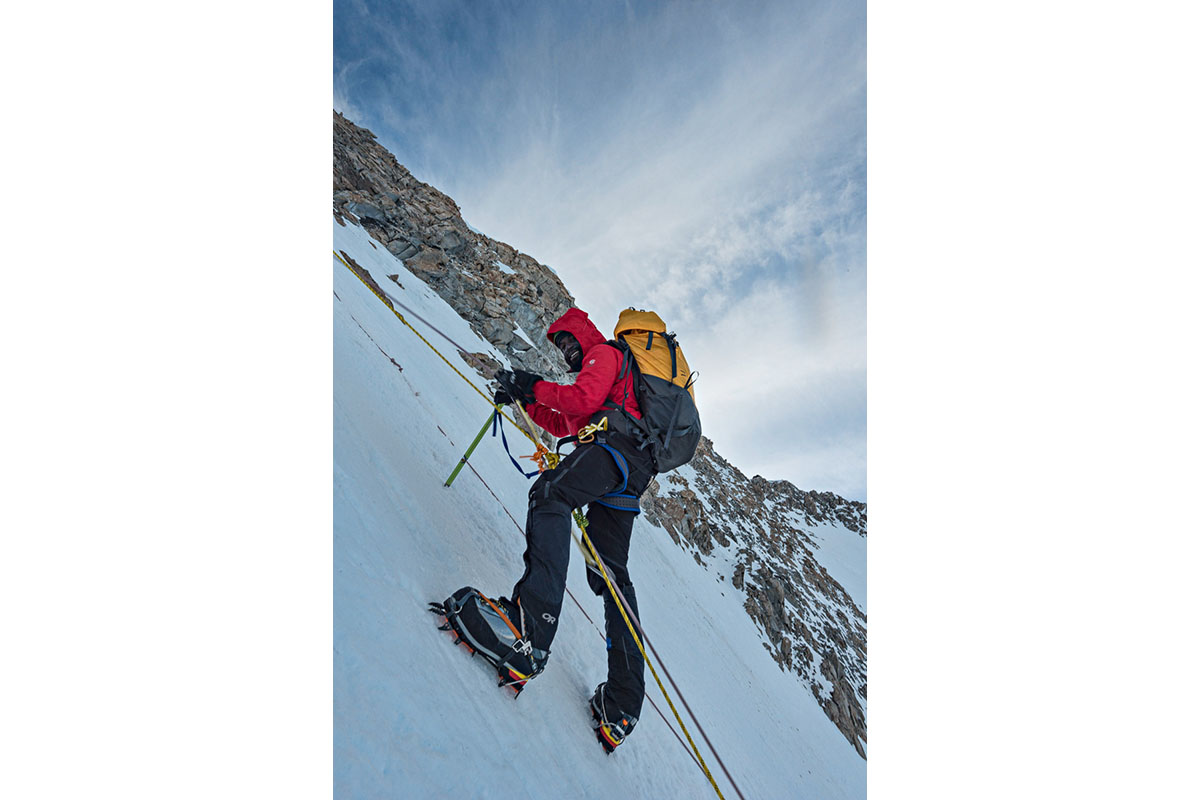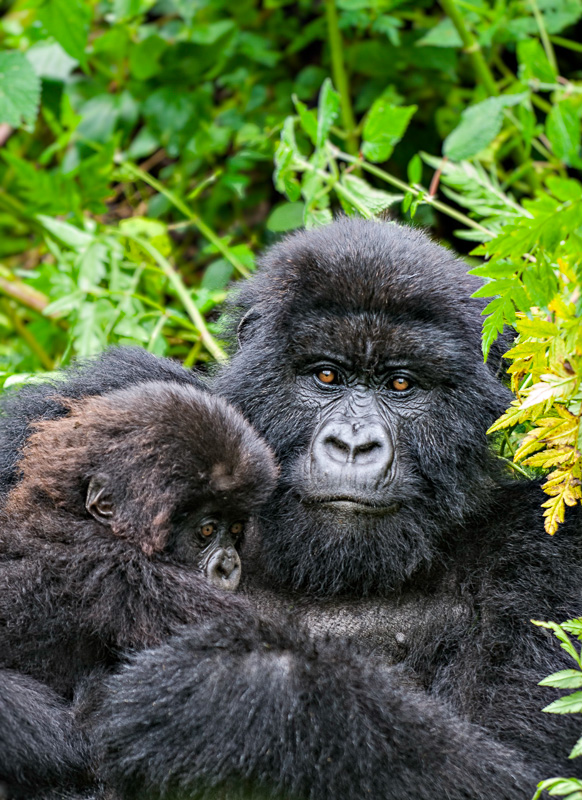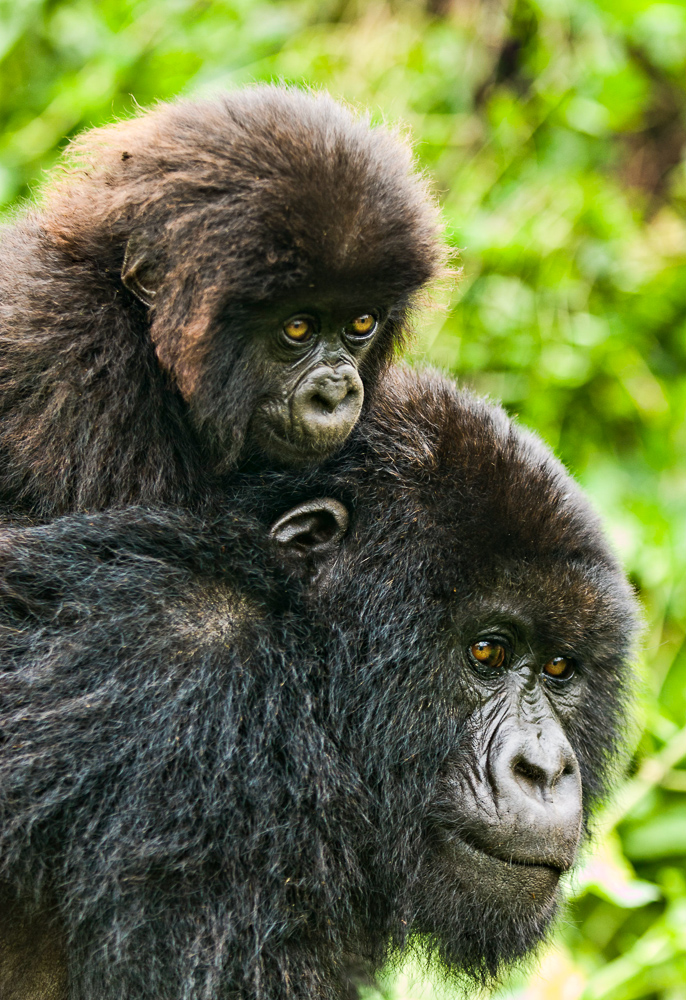This was Superbowl Sunday, the night after our film An American Ascent won some big awards down in San Diego. Andy, Beckey, Stacey and I ducked the crowds and met up with our friends Scott and Alexander for this epic photo session at Sunset Cliffs...
Read MoreFall Kisses Oneonta: Technical Details: Ultra High Res Pano-Merger Nikon D810, Nikkor 14-24 at F16 for 1sec at ISO64 (click image to enlarge)
Fall Kisses Oneonta
I had a lovely wet Oregon fall photo shoot in Oneonta Gorge with Hillary Younger and Gary Randall yesterday. The logjam we climbed was huge, the pool we waded deep. Hillary went in over her head, but the gear stayed dry. Good times with wonderful friends...
I've been wanting to create a panoramic merger of the back of Oneonta with the falls...
Read MoreSunrise Over Kilimanjaro: Technical Details: Nikon D700 Nikkor 70-200VR at F4 for 1/800sec at ISO200
Sunrise Over Kilimanjaro
This image is from a climb of Mt. Meru, outside Arusha, Tanzania . I left the saddle camp with my Climbing-Ranger Jafari before 2am to make Rhino Point at 13,000 feet before dawn. (Jafari is a saint and an artist at heart). Rhino Point has an EPIC view into Mt. Meru's massive crater.
As I finished shooting the first light on the crater, the clouds lit up with color around Mt Kilimanjaro across the valley. I pivoted the tripod. Then... serendipity! The rest of my crew came up the trail into my frame. I merely shouted "stop and check out the light on Kilimanjaro!" Then I framed up the image you see above.
Dawn Lights Mt. Meru: Technical Details: Nikon D700, Nikkor 14-24 at F5.6 for 1/320sec at ISO200 (click image to enlarge)
I always advocate that people planning a trip to climb Kilimanjaro allot an extra three days to first climb Mt. Meru (15,000 feet) in order to acclimatize. Having climbed them both, I can positively say that Meru was my favorite of the two. There is more wildlife, better views, less regulation, fewer people and much less expense involved. It's a wilder, more scenic mountain in many ways.
I've been slowly auditing my collection of past images. It's fun to look at favorites like this one with a fresh eye. One of the amazing benefits of our digital age is the ability to go back to a RAW image and rework it like a fresh piece of undeveloped film.
-Hudson
Stacey on Mt. Rainier. Technical Details: Nikon D800 Nikkor 24-120 at F8 for 1/500 sec at ISO 100
Thirty Six Hours in the Pacific Northwest
A couple of weeks ago I had one of those weekends that remind me why I love living and photographing in the Pacific Northwest.
My wife Stacey and I had planned a backcountry ski trip on Mount Rainier with friends that Sunday. As we headed north Saturday the weather was so perfect that we decided to stop by Sauvie Island on the Columbia river just north of Portland to get a little kiteboarding in.
Arriving at our local kite beach we found a number of our friends pumping up kites, laying out lines and heading out into the river on nice steady winds...
Read MoreThors Well: Cape Perpetua
Yesterday my friend Matt Kloskowski was in town and wanted to have a BIG northwest photo adventure. So Matt, the intrepid Rick Lepage and I started the morning off in wetsuits exploring waterfalls and slot canyons in the Columbia Gorge (stay tuned for that story). After a quick lunch, we grabbed our good friend Brian Matiash and headed southwest to Cape Perpetua on the Central Oregon coast for sunset and high tide at Thor's Well. All four of us have long been excited to photograph this powerful, tide-driven, salt-water fountain.
As Matt sped us over the coast range, the valley sunshine gave way to a fairly steady overcast. Undeterred by this development we arrived at Cape Perpetua about an hour before sunset, parked at the WRONG location and began looking for Thor's Well...
Read MoreFirst Look: Expedition Denali Trailer
I got a nice surprise this morning as I was unpacking from last weeks assignment. My friends at Distill Productions have finished their promotional trailer for the forthcoming documentary on Expedition Denali and it looks amazing. It was an incredible experience being a part of the film crew documenting this historic climb. Thanks to the Expedition Denali team, NOLS, our Kickstarter backers, and Distill Productions for helping to make it happen.
Without further ado, here is the fun stuff...
Purchase an Expedition Denali print in the adventure gallery of my store.
-Hudson
Expedition Denali Sierra Magazine Cover
This past summer it was my honor to join Distil Productions, and NOLS (the National Outdoor Leadership School) to document Expedition Denali, the first African American expedition to take on America's highest peak.
The January / February 2014 Issue of Sierra Magazine, the Sierra Club's national magazine, celebrates the historic expedition with the cover, a number of pages of my photos from the expedition as well as an interview with expedition members: Erica Wynn, Scott Briscoe, Rosemary Saal, and Stephen Shobe as well as our legendary NOLS instructor KG (James Kagambi).
Sierra is a world class publication with a very broad, intelligent and informed subscriber base; I'm more than pleased to have my image grace it's cover.
It's fun to watch the media coverage ramp up as Distill Productions continues editing the feature-length documentary.
Purchase an Expedition Denali print in the adventure gallery of my store.
-Hudson
The Enchantments
Perched high above a small, Bavarian-looking village and surrounded by jagged peaks lies an adventuresome backpacker’s dream: a glacier-carved granite valley filled with pristine blue lakes, sparse colorful trees, and abundant wildlife. For those of us fortunate enough to live in Pacific Northwest this magical valley is neither far away nor expensive to reach. We need drive no further than five hours from Portland, to the Enchantments of Washington state.
Early in the 20th Century the first European American visitor, US Geological Survey topographer A.H. Sylvester, named the area Enchantment Lakes. Sylvester wrote of his discovery:
"I found 5 or 6 most beautiful small lakes grouped in a wonderful glacial valley all ringed with alpine larch. From the highest lake over an entrancing fall tumbled the water it received from a small glacier. It was an entrancing scene."
Today a part of the Alpine Lakes Wilderness area, the Enchantments is about 15 miles southwest of Leavenworth, Washington, a wonderful town where it always feels a bit like Oktoberfest. Rare among Cascade basins, the lakes of the Enchantments rest above 7,000 feet in glacially carved granite. This makes the basin strikingly different. Here a hiker will not tread muddy forest trails to reach brushy lakeshores. Instead granite trails connect jewel-like lakes set against the rugged, panoramic backdrop of the Stuart Range. Scattered throughout the valley are mountain goats, waterfalls, and stands of Tamarack trees waiting to turn golden in the fall.
Like all great things, this scenic splendor does not come without sacrifice. There is no easy way into or out of the Enchantments. Each of the two main routes to reach the basin presents challenges. The more commonly recommended Snow Lake trail enters the Enchantments’ lower basin from the east and climbs 6,000 feet over a very long ten miles to get there. The shorter but more grueling route climbs Aasgard Pass above Colchuck Lake to reach the Enchantments’ upper basin from the west. While the Colchuck route is just under 6 miles long and gains less than 4,500 feet, more than half of that elevation is gained in the final mile ascending Aasgard Pass. Because ice, snow or sudden storms can make the steeps of Aasgard Pass highly treacherous, only experienced mountaineers with adequate equipment should consider this approach.
Once inside the basin memories of the rigorous ascent quickly fade. Find a campsite by one of the many pristine lakes and explore to your heart’s content. Fish, swim, hike, scramble up one of the surrounding peaks like Little Annapurna, or rope up and follow Fred Beckey’s route to the top of Prusik Peak. Commune with the mountain goats, but be careful to keep a safe distance. Photographers will be overwhelmed by the endless scenic possibilities. Here are a couple of inside tips: the larch trees are magnificent in the fall and the views afforded by a side trip up Prusik Pass are well worth the effort.
-Hudson
Where Sky Meets Sea
Don’t you love when you go out looking for something specific and wind up finding something totally unexpected along the way? That is exactly how I felt after capturing the photograph above one evening on Kauai.
I had spent three evenings at Ke’e beach waiting for the right sunset light to strike the island’s Na Pali coast. Na Pali is Hawaiian for “the cliffs,” and this coast is well named. It’s rugged mountain cliffs, swift rivers, waterfalls, and hanging valleys have kept this spectacular northwestern part of the Island wild and undeveloped.
One afternoon while exploring Ke’e beach, I encountered a series of rocky pools stretching far out into the tidal zone. I thought to myself that these pools would make a great reflecting foreground at sunset with the westward facing cliffs of Na Pali stretching into the distance.
Now after spending three nights wading around with my tripod waiting, I finally had that fleeting golden sunset light that I’d been waiting for. I found a pool that was just out of the tide’s reach and framed up the image you see to the right. I used a wide angle lens with a slow shutter speed and narrow aperture to keep the landscape sharp while blurring the moving waves to illustrate the pounding surf. I knew I had the image that I wanted.
That’s when the unexpected happened. As the sun rimmed down on the watery horizon, I looked behind me and saw the rain clouds out to sea starting to turn red. I quickly turned my attention directly into the backlit sunset. The exposure was really complicated and the light was changing fast. First I stacked two graduated neutral density filters to even out the foreground exposure with the brightness of the sky. Then I stopped down to drag the shutter and blur the surf beyond the pool my tripod and I were wading in.
I love the way this resultant image dramatizes blurred edges of the earth, sea and sky. It is one of my most popular prints and has run in national publications including Islands Magazine. The lesson? Never get so focused on a subject that you forget to look behind you.
-Hudson
Post Script: One of my favorite adventures on earth is to backpack the ancient Kalalau Trail down the Na Pali coast from Ke’e beach into the Kalalau Valley and back. This is not a trip to be taken lightly, but if you are are physically and mentally up to the challenge, the rewards are incredible.
Precious Few
The tingling in my spine comes not from the cold mountain air. I came to Rwanda to visit one of the most enigmatic animals on earth and here I stand staring into the eyes of a 500-pound wild mountain gorilla.
I left the town of Ruhengeri with rangers near dawn and traveled miles of bone-jarring, four-wheel-drive roads to reach Park National des Volcans (Volcanoes National Park). This island of protected mountain gorilla habitat in northwestern Rwanda consists of a series of steep cone-shaped, jungle-covered volcanoes. After hiking through the cultivated foothills, we start up the steep jungle paths through thickets of giant bamboo so dark I wish for a headlamp. The mud is so thick in places that it threatens to suck my boots off and is populated with earthworms the size of snakes. Stinging Nettles at least 10 feet tall overhang much of the trail and most of my body is covered in a icy-hot itch. This entire mountain range is teeming with life. I feel like I’m on the set of Jurassic Park.
After hours of climbing, my guide points to moving vegetation ahead and signals to be still. The leaves part and out sidles a large gorilla with a baby riding high on her back.
The moment I lock eyes with my first mountain gorilla all thoughts of the arduous journey to reach this place evaporate. These enormous animals display such a rare blend of intelligence, power and gentleness. I am spellbound. It takes some time for me to remember to turn on my camera, a VERY rare occurrence for me.
Mountain gorillas live in groups of several adult females and their young who are led and protected by a single adult male silverback. Silverbacks average about 490 pounds. Unlike lowland gorillas, mountain gorillas do not survive in captivity. Habitat loss, poaching and relentless war have reduced their surviving population to approximately 790 individuals.
Gorillas have incredibly expressive eyes. Joy, surprise, humor, curiosity, weariness, sorrow, and the whole range of emotion are on display in these big intelligent brown eyes. One by one more females come into view and begin grazing on bamboo and wild celery as babies play in their midst.
The gorillas often move so close that I might reach out to touch them. The entire group appears to care for the young gorillas together. They bounce from adult to adult playing wrestling and chasing each other up trees. The adults administer tickles, hugs, smiles, and occasionally discipline.
As a photographer, I am so fortunate that the mist and low overcast is blocking the harsh light of the midday sun. The light is soft and even.
Suddenly the brush ahead opens wide and the silverback appears. This gorilla is awe-inspiringly enormous. He is easily twice the size of the females and incredibly muscular. My spine tingles and I feel the hair rise on my arms. He stops and stares at me for a moment and I see a spark of curiosity. Thankfully he seems to feel no threat. If this gorilla wanted to, he could easily rip a person to pieces. It seems incongruous that these massive, powerful creatures have such a gentle nature. The silverback looks nearly as powerful as the brown bears I’ve encountered in the Arctic. However, unlike the solitary hunter-bear, this is a vegetarian family-ape. He sits down in the midst of his group and begins grazing on the lush vegetation.
Technical Details: Nikon D200, Nikkor 70-200 VR at F4.5 for 1/90th sec at ISO 400.
Mothers move about with small babies riding on their backs. Older gorillas pick up scampering little ones and hug them close making happy faces at them, just as I do when holding a human infant. Two young gorillas chase one another around the silverback as he watches approvingly. Alternating photographing and just watching these amazing creatures, I can’t help but worry about their future.
Park National des Volcans is bordered by one of the poorest, most densely populated areas on earth. Despite the steep mountainous terrain, nearly every square foot of land is terraced and cultivated. Tensions run high between people who need wood for fuel and those protecting the gorillas habitat. War, poaching and disease are a constant concern. Thankfully many dedicated people devote their lives to the protection of these remaining mountain gorillas and their habitat. Standing here amidst this family of gorillas, I fully understand that dedication.
All too soon it is time to leave the gorillas to their mountaintop and descend the long trail. Memories of the baby gorilla’s antics and all of the group’s expressive faces play across my mind as the miles of trail disappear behind my boots.
-Hudson





